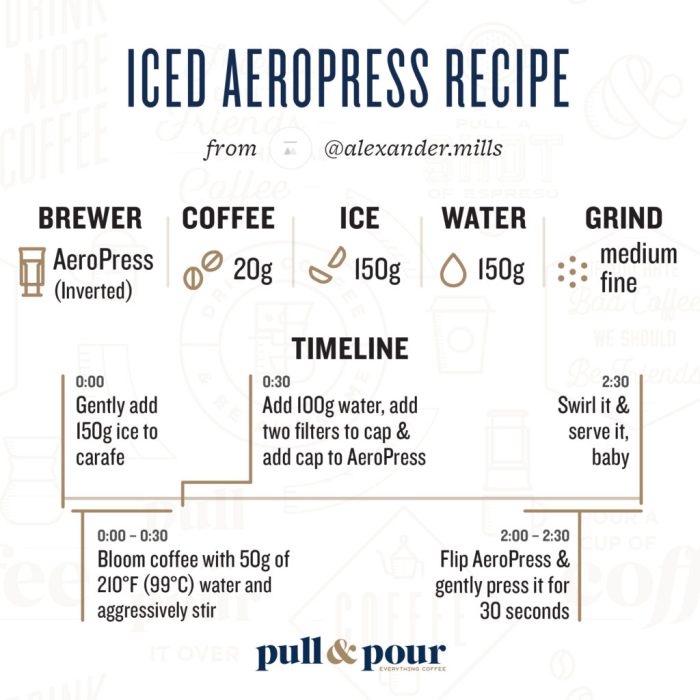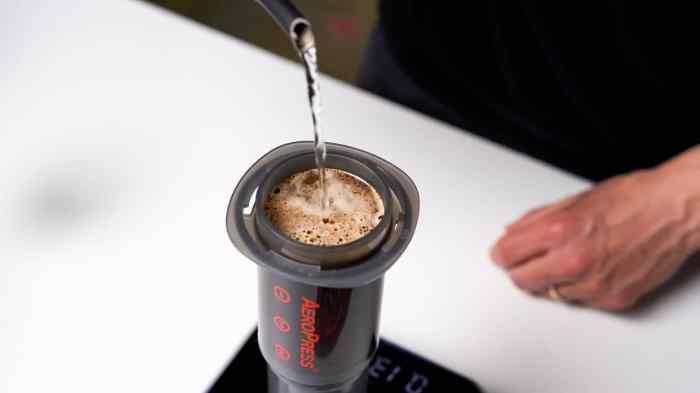Aeropress recipe is more than just a method for brewing coffee; it’s a gateway to a world of flavor and experimentation. The Aeropress, a simple yet ingenious device, allows you to craft delicious coffee at home, offering control over every aspect of the brewing process.
Whether you’re a coffee novice or a seasoned enthusiast, the Aeropress provides a versatile platform to explore the nuances of your favorite beans.
From the basics of using the Aeropress to advanced techniques and recipe variations, this guide will equip you with the knowledge to unlock the full potential of your Aeropress. We’ll delve into the essential equipment, explore different brewing methods, and provide tips for troubleshooting common problems.
Get ready to embark on a journey of coffee discovery, one cup at a time.
Introduction to Aeropress
The Aeropress, a versatile and compact coffee brewing device, has gained immense popularity among coffee enthusiasts since its invention in 2005. Its unique design and brewing method allow for a wide range of coffee styles, from bold and robust to smooth and delicate.The Aeropress utilizes pressure to force hot water through a bed of coffee grounds, resulting in a concentrated brew.
This process extracts a significant amount of coffee oils and solubles, producing a rich and flavorful cup.
Advantages and Disadvantages of Using an Aeropress
The Aeropress offers several advantages, making it an attractive choice for coffee brewing. Its portability, ease of use, and ability to produce high-quality coffee are just some of its key strengths. However, there are also a few drawbacks to consider.
- Portability:The Aeropress is incredibly compact and lightweight, making it ideal for travel or camping. Its simple design and minimal parts ensure easy packing and transport.
- Ease of Use:The Aeropress is known for its user-friendliness. With minimal steps and a straightforward brewing process, it’s easy to learn and master, even for novice coffee brewers.
- Versatility:The Aeropress allows for various brewing methods, from traditional immersion to inverted techniques. This versatility allows for experimentation and customization to achieve different coffee profiles.
- Cleanliness:The Aeropress is remarkably easy to clean. Its simple design and few parts make it a breeze to rinse and wash after each use.
- Affordability:Compared to other high-end coffee brewing devices, the Aeropress is relatively inexpensive. Its cost-effectiveness makes it accessible to coffee enthusiasts of all budgets.
- Limited Capacity:The Aeropress is designed for single-serving brewing. While it’s possible to brew multiple cups consecutively, it’s not as efficient as other brewing methods for larger quantities.
- Temperature Control:Achieving precise water temperature control can be challenging with the Aeropress. The lack of a built-in heating element requires using a separate kettle or hot water source.
- Potential for Mess:While the Aeropress is generally easy to use, there’s a slight risk of spills or messes during the brewing process, especially for beginners.
Aeropress Equipment and Supplies
The Aeropress is a simple yet versatile brewing device that requires minimal equipment. Let’s delve into the essential components and explore some optional accessories that can enhance your brewing experience.
Essential Components
The Aeropress consists of a few key parts that work together to create a delicious cup of coffee.
- Chamber:This is the main cylindrical part of the Aeropress, where the coffee grounds are placed. It features a filter holder at the bottom, which holds the filter.
- Plunger:This is the part that presses down on the coffee grounds, forcing the brewed coffee through the filter. The plunger has a seal that creates pressure and ensures a smooth extraction.
- Filter:The filter is a small, circular disc made of paper or micro-mesh material. It sits in the filter holder at the bottom of the chamber and traps coffee grounds, allowing only the brewed coffee to pass through.
- Cap:The cap fits on top of the chamber and holds the filter in place. It also features a hole that allows you to pour hot water into the chamber.
- Stirring Spoon:This is a small, plastic spoon used to stir the coffee grounds in the chamber before brewing. It helps to ensure even extraction.
Optional Accessories
While the basic Aeropress setup is sufficient for brewing coffee, there are a few optional accessories that can enhance your experience.
- Aeropress Go:This is a smaller, portable version of the Aeropress, designed for travel and on-the-go brewing. It comes with a carrying case and a travel mug.
- Filter Paper:The Aeropress comes with a few paper filters, but you can purchase additional packs for multiple brewing sessions. These paper filters are designed for single-use and provide a clean, clear brew.
- Micro-mesh Filter:For a more robust and reusable filter option, consider a micro-mesh filter. These filters are made of fine stainless steel mesh and can be cleaned and reused multiple times.
- Aeropress Attachment:There are a variety of attachments available for the Aeropress, such as the AeroPress Coffee Maker, which allows you to brew multiple cups of coffee at once. These attachments can expand the versatility of your Aeropress.
Maintaining and Cleaning the Aeropress, Aeropress recipe
Maintaining and cleaning your Aeropress is crucial for ensuring optimal performance and longevity.
- Cleaning After Each Use:After each brewing session, rinse the chamber, plunger, and cap with hot water. Remove any coffee grounds residue. For the filter, dispose of paper filters or rinse and dry micro-mesh filters.
- Deep Cleaning:For a more thorough cleaning, you can soak the chamber and plunger in warm, soapy water. Avoid using abrasive cleaners or scouring pads, as they can damage the plastic.
- Storing the Aeropress:Store your Aeropress in a dry and cool place. Keep the chamber and plunger separated to prevent any unwanted odors or flavors from developing.
Basic Aeropress Recipe
The Aeropress is a versatile brewing device that allows for a wide range of coffee styles, from bold and robust to light and delicate. This recipe provides a basic foundation for brewing delicious coffee with your Aeropress.
Basic Aeropress Brewing Method
The basic Aeropress brewing method is a simple and straightforward process. It involves immersing coffee grounds in hot water for a set amount of time, then pressing the coffee through a filter to produce a concentrated brew.
- Grind the coffee beans: Grind your coffee beans to a medium-fine grind, similar to table salt. The grind size can be adjusted based on your preference for coffee strength and flavor.
- Assemble the Aeropress: Attach the filter cap to the Aeropress chamber and place it on top of your mug or serving container.
- Add the coffee grounds: Add 1-2 tablespoons of ground coffee to the Aeropress chamber.
- Pour hot water: Pour 8-10 ounces of hot water (around 175-205°F) over the coffee grounds.
- Stir the coffee: Gently stir the coffee grounds and water for about 10 seconds to ensure even extraction.
- Steep the coffee: Allow the coffee to steep for 1-4 minutes, depending on your preference for strength and flavor.
- Press the coffee: Slowly press the plunger down to force the coffee through the filter and into your mug.
- Enjoy your coffee: Pour your freshly brewed coffee and savor the rich flavors.
Aeropress Brewing Methods
There are various methods for brewing coffee with an Aeropress. The choice of method depends on your preference for coffee strength, flavor, and brewing time.
| Method | Description | Variations |
|---|---|---|
| Immersion | This method involves immersing the coffee grounds in hot water for a set amount of time, then pressing the coffee through a filter. |
|
| Inverted | This method involves inverting the Aeropress chamber and pressing the coffee through the filter from the bottom. |
|
| Cold Brew | This method involves steeping coarsely ground coffee in cold water for an extended period, typically 12-24 hours. |
|
Advanced Aeropress Techniques
Mastering the Aeropress involves exploring beyond the basic recipe and experimenting with different techniques to unlock a wider range of flavors and customize your coffee experience. Here, we’ll delve into some advanced techniques that can significantly impact your brew.
Grind Size and Its Influence on Extraction
The grind size plays a crucial role in the extraction process, influencing how much coffee is dissolved in the water and ultimately affecting the flavor profile of your brew.
- Fine Grind:A fine grind offers a greater surface area for the water to interact with the coffee grounds, leading to a faster extraction and a stronger, more concentrated brew. However, over-extraction can result in bitterness and a harsh taste.
- Medium Grind:This grind size provides a balanced extraction, allowing for a well-rounded flavor profile without excessive bitterness or under-extraction. It’s a good starting point for most Aeropress recipes.
- Coarse Grind:A coarse grind offers less surface area, resulting in a slower extraction and a weaker, lighter brew. This grind size is suitable for those who prefer a more delicate and less intense coffee flavor.
Water Temperature and Its Impact on Coffee Flavor
Water temperature is another crucial factor influencing the extraction process and ultimately the flavor of your brew.
- Ideal Temperature:The ideal water temperature for brewing coffee is generally considered to be between 195°F and 205°F (90°C and 96°C). This temperature range allows for optimal extraction of the coffee’s desirable compounds, resulting in a balanced flavor profile.
- Too Hot:Water that is too hot can cause over-extraction, leading to bitterness and a burnt taste. It can also damage the delicate coffee beans, affecting the flavor profile.
- Too Cold:Water that is too cold will result in under-extraction, leading to a weak and bland coffee flavor. The extraction process will be slower, and the coffee may not reach its full potential.
Pre-infusion and Its Benefits
Pre-infusion is a technique that involves soaking the coffee grounds in a small amount of water before starting the full extraction process. This technique offers several benefits:
- Even Extraction:Pre-infusion helps to evenly saturate the coffee grounds, ensuring a more consistent and complete extraction.
- Reduced Bitterness:By allowing the grounds to bloom, pre-infusion can help to reduce bitterness by releasing the trapped gases and CO2 that can contribute to a harsh flavor.
- Enhanced Flavor:Pre-infusion can enhance the overall flavor profile of the coffee by allowing for a more controlled and nuanced extraction.
Aeropress Recipes for Different Coffee Preferences
The Aeropress is incredibly versatile, allowing you to tailor your brew to your taste. From bold and strong to light and fruity, there’s an Aeropress recipe for everyone. Here, we’ll explore various recipes designed to satisfy different coffee preferences.
Recipes for Different Coffee Preferences
This table presents recipes for various coffee preferences. | Preference | Coffee Ratio (grams coffee : ml water) | Grind Size | Brew Time ||—|—|—|—|| Strong | 1:10 | Fine | 2:00 || Medium | 1:15 | Medium | 2:30 || Mild | 1:20 | Coarse | 3:00 |
Recipes for Specialty Coffee
You can use the Aeropress to brew specialty coffee, such as espresso and cold brew.
Espresso
For a concentrated espresso-like brew, use a fine grind and a 1:1 coffee-to-water ratio.
Use 18 grams of coffee and 18 ml of water.
Cold Brew
For a smooth and refreshing cold brew, use a coarse grind and a 1:8 coffee-to-water ratio.
Use 30 grams of coffee and 240 ml of water.
Adjusting Recipes to Your Taste
Adjusting your Aeropress recipe is simple. Here are some tips:* Grind Size:A finer grind results in a stronger brew, while a coarser grind produces a milder brew.
Brew Time
A longer brew time extracts more coffee, resulting in a stronger brew.
Water Temperature
Use hotter water for a stronger brew, and cooler water for a milder brew.
Obtain access to beefaroni recipe to private resources that are additional.
Coffee Ratio
Increase the coffee ratio for a stronger brew, and decrease it for a milder brew.
Aeropress Troubleshooting and Tips

The Aeropress, while a relatively simple device, can sometimes present challenges. Understanding common issues and their solutions can help you brew consistently delicious coffee.
Troubleshooting Common Aeropress Problems
Troubleshooting can help you identify and resolve issues, leading to a smoother and more enjoyable brewing experience.
- Weak Coffee:This can be due to several factors. Insufficient grind size, over-extraction, or using too much water can all contribute to weak coffee.
- Bitter Coffee:Over-extraction is the primary culprit for bitterness. This occurs when the coffee grounds are exposed to hot water for too long, resulting in excessive extraction of bitter compounds.
- Uneven Extraction:This often results in a cup of coffee with both weak and bitter notes. Uneven extraction can occur due to inconsistent grinding, improper water distribution, or inadequate pressure during brewing.
- Clogging:The Aeropress filter can sometimes clog, preventing water from flowing through the coffee grounds. This can be caused by using too fine a grind or by using a filter that is too old or damaged.
Solutions and Tips for Common Problems
These solutions can help you address specific issues and optimize your brewing process.
- Weak Coffee:
- Grind Size:Use a coarser grind, allowing water to pass through the coffee grounds more quickly.
- Extraction Time:Reduce the extraction time by pressing the plunger faster.
- Water Ratio:Use less water to increase the coffee concentration.
- Bitter Coffee:
- Grind Size:Use a slightly coarser grind to allow for faster extraction.
- Extraction Time:Reduce the extraction time by pressing the plunger sooner.
- Water Temperature:Use slightly cooler water, as hotter water can extract more bitter compounds.
- Uneven Extraction:
- Grind Consistency:Ensure your coffee beans are consistently ground.
- Water Distribution:Pour water evenly over the coffee grounds, ensuring all grounds are adequately saturated.
- Pressure:Apply consistent pressure during brewing, avoiding sudden changes in pressure that can lead to uneven extraction.
- Clogging:
- Grind Size:Use a slightly coarser grind to prevent clogging.
- Filter:Replace the filter if it is old or damaged.
- Pre-infusion:Before pressing, pour a small amount of water over the grounds to pre-infuse them, allowing the filter to expand and prevent clogging.
Optimizing Coffee Extraction with the Aeropress
These tips can help you extract the best flavors from your coffee.
- Water Temperature:Use water between 195°F and 205°F (90°C to 96°C) for optimal extraction.
- Grind Size:Experiment with different grind sizes to find the optimal setting for your preferred coffee strength and flavor.
- Brew Time:Adjust the brew time by pressing the plunger at different intervals to find the perfect balance of flavor and strength.
- Water Ratio:Adjust the water ratio to your preference, using more water for a weaker brew or less water for a stronger brew.
- Pre-infusion:Before pressing, pour a small amount of water over the coffee grounds to pre-infuse them, allowing for a more even extraction.
- Stirring:Gently stir the coffee grounds during the brew process to ensure even extraction.
- Cleanliness:Always clean your Aeropress thoroughly after each use to prevent any build-up of coffee grounds that could affect future brews.
Aeropress in the Coffee World

The Aeropress, with its unique design and versatility, has carved a distinct niche in the coffee brewing landscape. It stands out as a method that seamlessly blends simplicity, control, and quality, making it a favorite among coffee enthusiasts and professionals alike.
Comparison with Other Brewing Methods
The Aeropress distinguishes itself from other brewing methods by offering a unique combination of features. Let’s compare it to some popular alternatives:
- French Press:The French press, known for its full-bodied brews, relies on immersion to extract coffee. Unlike the Aeropress, it doesn’t offer as much control over brew strength or temperature.
- Pour Over:Pour over methods, like the V60 or Chemex, emphasize manual control and precise pouring techniques. While they can produce incredibly clean and flavorful cups, they often require more practice and attention to detail. The Aeropress, on the other hand, offers a more forgiving and less time-consuming approach.
- Espresso Machine:Espresso machines are renowned for their high pressure and concentrated brews. While they offer unparalleled control over extraction parameters, they can be expensive and require significant setup. The Aeropress provides a more accessible and budget-friendly way to achieve a similar level of richness and complexity.
The Aeropress’s Role in the Coffee Community
The Aeropress has gained immense popularity in the coffee community for several reasons:
- Ease of Use:Its simple design and intuitive operation make it accessible to both beginners and experienced coffee brewers.
- Portability:Its compact size and lightweight construction make it ideal for travel, camping, or simply brewing coffee on the go.
- Versatility:The Aeropress can produce a wide range of brew styles, from light and bright to bold and rich, depending on the grind size, water temperature, and brewing technique.
- Affordability:Compared to other brewing methods, the Aeropress is relatively inexpensive, making it a great option for budget-conscious coffee lovers.
Resources for Further Exploration
There are numerous resources available for learning more about Aeropress brewing and the world of coffee:
- Online Communities:Websites and forums dedicated to Aeropress brewing, such as the Aeropress subreddit and the Aeropress Facebook group, provide a platform for sharing tips, recipes, and discussions with fellow enthusiasts.
- Blogs and Articles:Many coffee blogs and websites offer detailed articles, tutorials, and reviews on Aeropress brewing techniques and recipes.
- Books:Several books have been published specifically on Aeropress brewing, providing comprehensive guides to the method and its various applications.
- Coffee Shops and Roasters:Local coffee shops and roasters often host Aeropress brewing workshops and events, offering hands-on experience and expert advice.
Final Review

With the Aeropress, the possibilities for brewing coffee are endless. Experiment with different beans, grind sizes, water temperatures, and brewing times to find your perfect cup. Whether you prefer a bold and robust brew or a smooth and mellow cup, the Aeropress allows you to tailor your coffee experience to your unique taste preferences.
So, grab your Aeropress, your favorite beans, and get ready to explore the world of coffee brewing. You’ll be amazed at the delicious and versatile coffee you can create right in your own kitchen.
